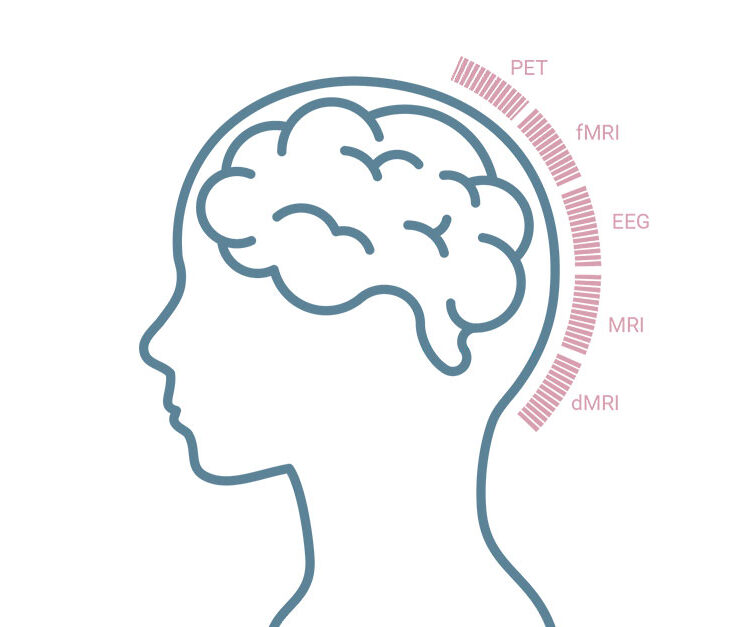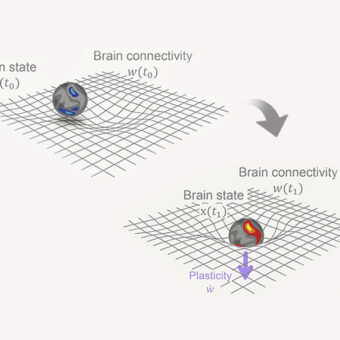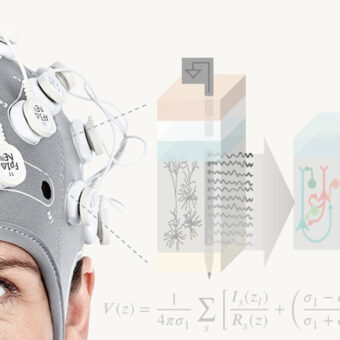Have you ever wondered how psychedelics alter our perception and consciousness? Can the effects induced by these substances be measured and characterized? In our recent work, we set out to shed light on these questions by investigating the impact of psychedelics on brain dynamics. Using functional magnetic resonance imaging (fMRI) data, we aimed to characterize two distinct brain states: one induced by psychedelics and the other by a placebo.
By employing the Ising spin model and algorithmic complexity, we aimed to uncover the underlying mechanisms and discern the intricate changes occurring within the brain during these states.
Psychedelics in Neuroscience research
The study of psychedelics in neuroscience research has been captivating due to their profound effects on perception, consciousness, and the interconnected nature of human experience.
One prominent theory in the field, known as REBUS (Relaxed Beliefs Under Psychedelics), provides a framework for understanding the effects of psychedelics on brain dynamics. According to REBUS, the psychedelic experience arises from the temporary destabilization of established neural networks and belief systems, allowing for novel and expanded patterns of thinking.
During normal waking consciousness, our brains function within stable and predictable patterns, shaped by our prior experiences, beliefs, and assumptions. However, when subjected to psychedelic substances such as LSD, psilocybin, or DMT, these rigid patterns can temporarily loosen their grip. This can lead to a state of heightened plasticity, where the brain becomes more open to novel connections and alternative perspectives.
Psychedelics have been found to modulate various neurotransmitter systems, particularly serotonin, which plays a crucial role in mood regulation and perception. By interacting with serotonin receptors, psychedelics alter the balance of neural activity, leading to increased information transfer between brain regions that are typically segregated.
The effects of psychedelics on brain dynamics can be observed through various neuroimaging techniques, including fMRI. fMRI allows us to examine changes in blood flow and oxygenation, providing insights into alterations in neural activity and connectivity during the psychedelic experience. These changes in brain dynamics have been associated with the unique effects reported by individuals under the influence of psychedelics.
Also, the study of psychedelics holds promise for uncovering novel therapeutic applications. Research has shown potential benefits in treating mental health conditions such as depression, anxiety, and post-traumatic stress disorder (PTSD), suggesting that these substances may offer new avenues for therapeutic interventions.
Understanding the Ising model
In this study, we use the concept of the Ising spin model. Imagine a simplified representation of a collection of interacting particles, such as atoms or molecules. Each particle possesses a “spin,” which can be either up or down, similar to the magnetic poles. The spins interact with their neighbors, influencing their orientation. This simple magnet model allows us to observe how the spins align or remain disordered. Temperature plays a key role in the alignment of spins, as shown in Figure 1.
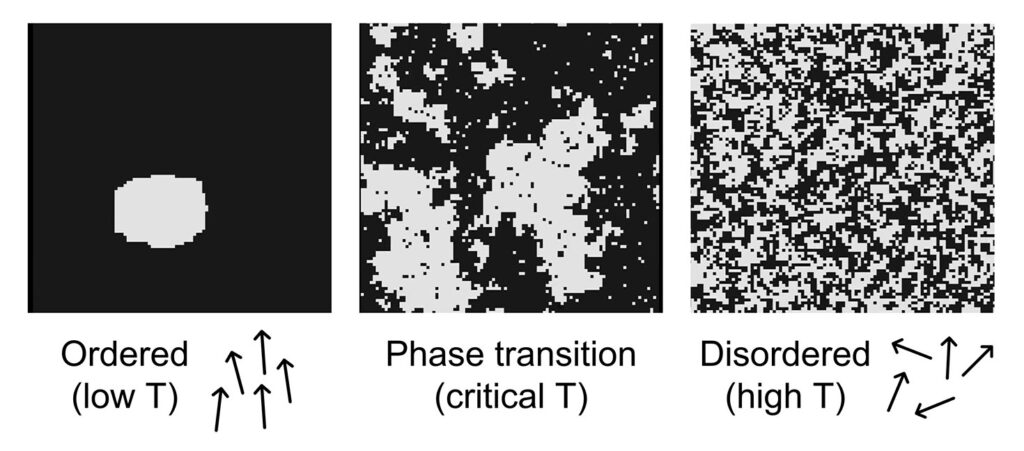
The critical point represents the state of the system where the balance between order and disorder is delicately poised. At criticality, rich dynamics and emergent behaviors can occur. In our study we use an extended version of the Ising model where all the spins can be influenced by all the other ones in the system. In our model, a spin corresponds to the fMRI activity in a brain region. If the activity is above a certain threshold, we assign it to +1. Otherwise, we assign it to -1. Here, the threshold is the median of the fMRI activity in that brain region. This method was adapted from a previous work by Ezaki et al., 2019.
Understanding algorithmic complexity
Another key tool used in our study is algorithmic complexity. Complexity, in this context, refers to the degree of intricacy, unpredictability, and organization within a sequence of data or information. It allows us to assess the level of randomness or order present in a series of events or patterns. To illustrate algorithmic complexity, let’s consider two sequences:
Sequence A: 0101010101010101
Sequence B: 0101011010010010
In Sequence A, we observe a repetitive pattern of alternating 0s and 1s. This sequence follows a straightforward and predictable structure, showing low algorithmic complexity. In contrast, Sequence B displays a more complex and unpredictable pattern. It does not follow a simple repetitive structure, and the arrangement of 0s and 1s appears less regular, so it results in a higher level of algorithmic complexity.
In our research, we specifically use the Lempel-Ziv-Welch and Block Decomposition techniques to evaluate the complexity of brain dynamics under various conditions.
The LSD experiment
Our study focused specifically on the effects of LSD, one of the most potent psychedelics known. Robin Carhart-Harris and colleagues conducted an experiment in which fifteen participants were administered either LSD or a placebo. During the experiment, participants underwent fMRI scans while in a resting state. This allowed researchers to observe the spontaneous brain activity and connectivity patterns in both the LSD and placebo conditions.
Results and their significance
Our analysis of the fMRI data revealed insights into the differences in brain dynamics between the LSD-induced state and the placebo state. One notable observation was an increase in the Ising temperature during the psychedelic state. Higher Ising temperatures indicate increased disorder.
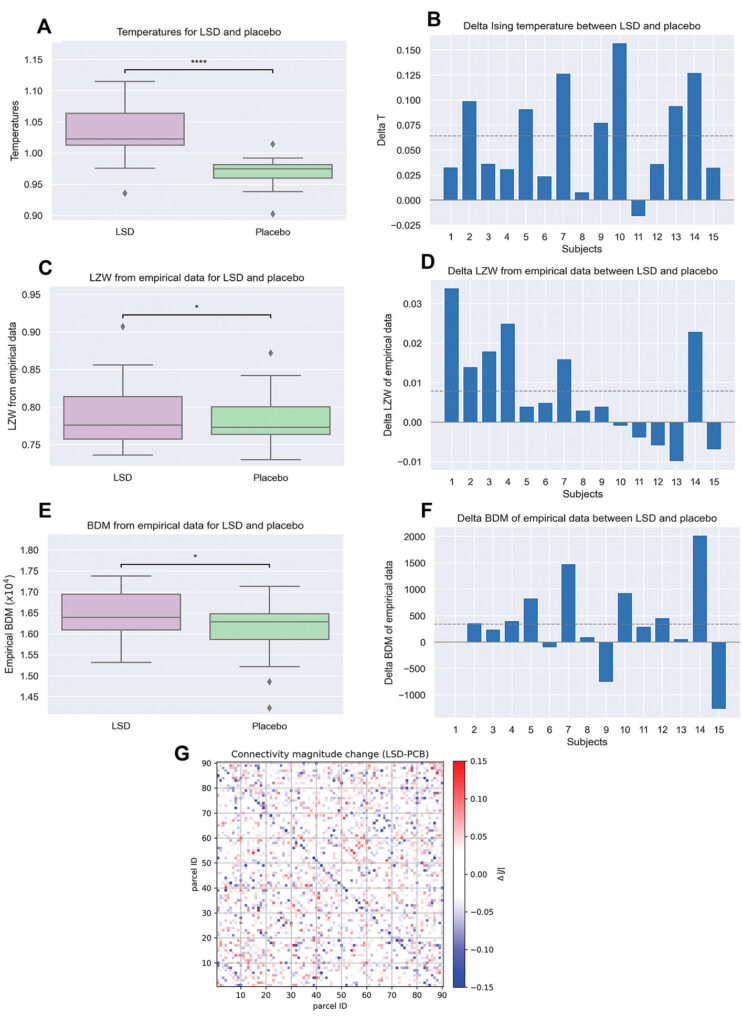
To study the complexity of the fMRI data in the two conditions, we used the Lempel-Ziv-Welch (LZW) and block decomposition method (BDM) analyses. The LZW complexity analysis indicated a weak statistical relationship with the condition, while the BDM complexity analysis revealed a significant correlation with the Ising temperature and a weak but significant correlation with the condition. These results suggest that the effects of LSD increase the complexity of brain dynamics and push the system further away from criticality into a more disordered state.
Moreover, our study demonstrated that connectivity between the two hemispheres exhibited a significant decrease during the LSD condition. This decrease in connectivity suggests a loosening of functional connections between corresponding brain regions.
Furthermore, when comparing the global archetype Ising models generated for each condition, we observed that the Ising connectivity in the LSD condition was lower than in the placebo condition.
Consistent with earlier research and theories like REBUS, the anarchic brain hypothesis, and the algorithmic information theory of consciousness, we observed that the effects of LSD translated into increased complexity of the BOLD signal and Ising temperature. This suggests a shift towards a more disordered state induced by psychedelics.
Contrary to some previous results using different methods than ours, we discovered that the placebo condition already existed above the critical point in the “disordered” phase. However, when LSD was ingested, we observed a further departure from Ising criticality, pushing the brain into an even more disordered state.
Why are the results relevant for brain stimulation
So, how does this research relate to Neuroelectrics and the field of brain stimulation? The increased brain plasticity induced by psychedelics holds significant relevance. When the brain is more plastic, it becomes more malleable and responsive to change. This insight has implications for brain stimulation techniques. By understanding how psychedelics influence brain activity, we can potentially uncover new opportunities for optimizing and enhancing the effectiveness of brain stimulation interventions. The study of psychedelics opens doors to targeted interventions that harness the enhanced plasticity of the brain, offering promising prospects for therapeutic applications developed by Neuroelectrics.
Conclusions
In conclusion, our study delved into the fascinating realm of psychedelics and their effects on brain dynamics. Using fMRI data and applying the Ising spin model and algorithmic complexity, we unraveled intriguing patterns and changes in the brain induced by LSD. These findings contribute to our understanding of consciousness, open new doors for therapeutic research, and hold promise for the future of brain stimulation. As we continue to explore the mysteries of the mind, the enigmatic effects of psychedelics may shed light on how our consciousness works.
